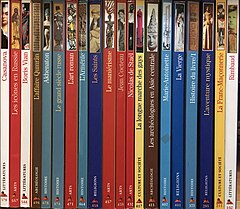Livre d'art
Livres d'art (French for art books or books of art), otherwise referred to as livres de galerie (French for gallery books), are books in which the illustration holds a predominant place in relation to the text. They often require high quality papers as they belong in the category of high quality publications.[1]
History
[edit]According to a presentation from Élie Faure's Histoire de l'art (originally published from 1919–1921), the livre d'art is a new genre within the field of modern art, where each commentary (text) can be compared to the works (works of art, images) themselves, the juxtaposition and confrontation of images justifying the audacity of the connections between text and image which sometimes seem unusual.[2]
The Éditions Hazan, a Paris-based publisher specialising in producing livres d'art, which presents itself as la référence du livre d'art,[3] launched a collection of artist monographs entitled "ABC" at the end of the 1950s. The books were produced in pocket format and intended for a general audience. Since 1980, the Prix Élie-Faure has been presented on an annual basis to reward the best livre d'art.[4]

The "Découvertes" collection launched by Éditions Gallimard in 1986 is a new kind of artistic encyclopaedia with a dynamic page layout.[5] Produced in pocket format and illustrated in colour, these books treat a wide range of subjects such as arts, archaeology, history, literature, music, philosophy, religion, sports, technology, all based on an abundant pictorial documentation and a way of bringing together visual documents and texts, enhanced by printing on coated paper. As commented in L'Express: "All served by omnipresent iconography, which is in harmony with the text. [...] In short, genuine monographs, published like art books. [...] 'Découvertes' changed the face of encyclopaedism and art book, adapting the book to the era of 'zapping'."[6]
In 2003, the Prix Livre d'art of the awards ceremony La Nuit du livre was established by Élisabeth Chainet, according to her, the prize "celebrates beauty in books, these masterpieces that reveal two talents: that of the author, whether he is a writer, photographer or illustrator, but also that of the manufacturer. The beauty of a book is in fact the result of a perfect encounter between the intellectual world of the author and the technical world of the manufacturer."[7] Mimmo Paladino's Iliade and Odyssée became the first winners of the prize, which are outstanding for their "adequacy between Paladino's illustrations and Homer's texts, the quality of page layout by Richard Médioni, the choice of paper, typography, binding, etc."[8]
See also
[edit]References
[edit]- ^ "Communication de l'autorité de surveillance AELE sur la définition du marché en cause aux fins du droit de la concurrence dans l'espace économique européen (EEE)". Journal officiel de l'Union européenne (in French). 1998. Retrieved 4 December 2021.
On trouve généralement sur le marché toute une gamme de qualités de papier, depuis le papier d'impression standard jusqu'au papier de qualité supérieure utilisé, entre autres, pour les livres d'art. Du point de vue de la demande, on n'utilise pas indifféremment ces différentes qualités de papier; par exemple, on n'imprime pas un livre d'art ou un ouvrage de luxe en utilisant un papier de qualité médiocre.
- ^ Faure, Élie (25 May 1988). Histoire de l'art, tome IV, volume 2 : L'art moderne II. Collection « Folio essais » (nº 66) (in French). Paris: Éditions Gallimard. ISBN 9782070324217.
- ^ "Hazan : La référence du livre d'art". editions-hazan.fr (in French). Retrieved 4 December 2021.
- ^ "Prix Elie-Faure 87 du meilleur livre d'art". lemonde.fr (in French). 11 December 1987. Retrieved 4 December 2021.
- ^ Cova, Bernard; Svanfeldt, Christian (1993). "Societal Innovations and the Postmodern Aestheticization of Everyday Life". International Journal of Research in Marketing. 10 (3). Amsterdam: Elsevier: 297–310. doi:10.1016/0167-8116(93)90012-N. Retrieved 4 December 2021.
- ^ Garcia, Daniel (1 November 2005). "L'invention des Découvertes". lexpress.fr (in French). Retrieved 4 December 2021.
Le tout servi par une iconographie omniprésente, en osmose avec le texte. [...] Bref, de véritables monographies, éditées comme des livres d'art. [...] « Découvertes » a changé la face de l'encyclopédisme et du livre d'art, adaptant le livre à l'ère du « zapping ».
- ^ "La Nuit du livre : Présentation". lanuitdulivre.com (in French). Retrieved 4 December 2021.
- ^ "Prix du livre d'art de la Nuit du Livre 2003". editionsdianedeselliers.com (in French). 1 April 2003. Retrieved 4 December 2021.
